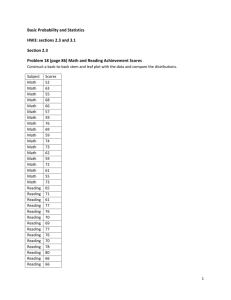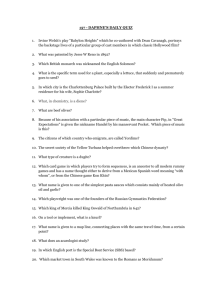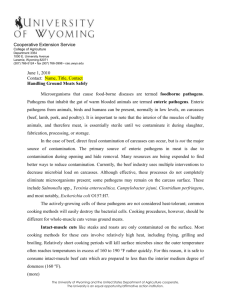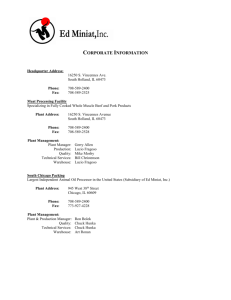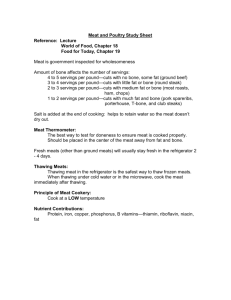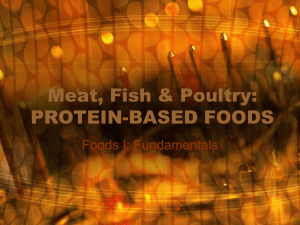Meats
advertisement
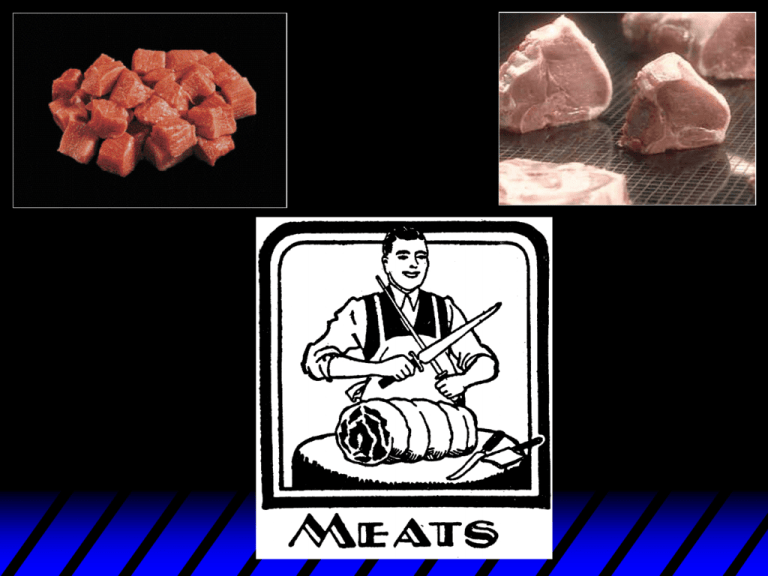
Meats Usually the most expensive of all food items 30-70% of food cost 20-40% of operating cost Make-up: – 75% water, 20% protein, 5% fat – Shrinkage and deterioration Humidity Temperature Animal Fat 5% of animal tissue 30% of carcass? Bred and raised leaner Some fat is desirable . . . Fat is not all bad! Juiciness – Marbling “Juiciness” when eating Tenderness Muscle Surface fibers separated by fat Fat Protects during cooking Flavor The “Beefy” flavor is fat soluble Meats 3 Connective Tissue is Tough to Eat! – Collagen and elastin – Old versus young – Use of muscle – Marbling ROT for Cooking Much collagen? – Long, slow, moist cooking. Collagen Much dissolves into gelatin and water elastin? – Remove – Mechanically tenderize Grind, cube, slice very thin, pound, – Break up the fibers! Meats: Inspections and Grading Authorized by Agricultural Marketing Act The Wholesome Meat Act – All meat must be inspected – Grading is voluntary Quality Yield The Seal of Approval? The Circular Inspection Stamp – Wholesome and Fit for Human Consumption The Shield shaped Grading stamp – A Quality Designation Clearly specified Quality Beef – – – – – – – Prime Choice Select Standard Commercial Utility Cutter Canner Veal and Lamb – Prime – Choice – Good and more Quality Proprietary Quality Grade? – Caveat Emptor! Know your supplier – You can none-the-less specify USDA grade Yield Ratio of fat to meat – 1 is highest yield Beef 1-5 Pork 1-4 Lamb/Mutton 1-5 Veal is not yield graded – Naturally lean Aged Meat? Green Meat – Myosin and Actin Stiff and inelastic Aged Meat? Tenderize: – – – – – Natural High temperature Enzymatic Vacuum aging Electrical stimulation Tenderize: – Dry aging May lose up to 20% of moisture content – Wet aging Less initial moisture loss – Greater cooking loss Aged Meat Slightly If changed flavor profile meat smells (or tastes) spoiled, it probably is Meat Cuts Four forms: – Carcass – Partial carcass – Primal cut – Fabricated cuts (pre-fabs) IMPS or NAMPS 7 Bone Structure Important to know: – Help identify a cut of meat – Help minimize loss when de-boning – Help you avoid messy carving/carving loss Know the carcasses Cooking Meats Low temp if possible ID-the connective tissue/cut – ROT for cooking methods: Moist heat – Larger or tougher cuts Dry heat – Smaller or tender cuts 8 Rib and Loin Cuts The most tender (on any animal) Beef and Lamb – Often served rare to medium: roast, broil or grill. Veal and Pork – Generally eaten (more) well done: as above, but also braised on occasion. Leg or Round Beef (round) – Typically less tender braise – Roasting OK for Prime or Choice Marbling cooking time - beef’s own moisture helps tenderize Long Leg or Round Veal, Lamb or Pork (leg) – More tender than beef Younger!! Excellent for roasting Chuck or Shoulder Beef Veal, Braise Lamb and Pork Braise or Roast NB: The shoulder may be tender, but will have multidirectional muscle tissue Shanks, Breasts, Briskets and Flank Usually not tender even on young animals – Shanks are high in collagen: excellent for braising – Beef flank, if carefully cut across the grain, can be broiled: London Broil Mechanically tenderized meats, such as cubed or ground, can be cooked by dry or moist heat Searing and blanching? . . . does not seal in the juices ! Do not cook meats when frozen Does not retain or increase moisture – Same or slightly increased (delayed) Complicates the cooking process – Timing – Surface dry and done - center frozen Waste of energy and time Doneness? Dry heat vs. Moist heat Carry-over cooking Critical for product quality Doneness? Color Change – Red Meats “Blue” – Barely seen the heat, cold and “blue” center “Rare” – Browned surface, thin grey layer, red interior, slightly warm. “Medium” – Browned surface, more grey, pink center. “Well Done” – Grey throughout Doneness? Interior temperature the best approach: – Beef: Rare: – 130 F Medium – 140-145 F Well done – 160 F Doneness for White Meats? Pork: – Cooked well done: 160-170 F Must pass 137 F throughout for minimum 10 seconds to avoid trichinosis! Play it safe and hit 150 -155 F (FDA) Veal – Generally cooked well done – Hues of pink increasingly accepted in the most tender cuts Doneness by Touch? Takes much experience! – Small steaks/chops Touch the raw product first! – Rare: Firmer, but still soft and pliable – Medium: Firmer, springs back – Well done: Firm, does not yield to pressure Dry Heat Meat Cookery Seasoning – If you season just prior to roasting Only fractions of an inch will be seasoned Browning will be retarded – 3 choices: Season several hours/days in advance Season after roasting Do not season, but have a well seasoned sauce Roast fat side up Basting only needed for lean meats – Baste with fat, not stock – Bard (cover with fat) or lard Broil, grill, pan broil – browning and internal doneness – ROT: the shorter the cook time (the rarer the interior), the higher the temperature – brush with oil if necessary, avoid the “oil dip” Sauté and Pan Fry – Only tender cuts! – The smaller or thinner the piece the higher the heat – ROT for sauté: Hot pan Do not overcrowd Flip only as needed – Deglazing Moist Heat Cookery Simmering – Fresh meats, start with boiling liquid – Cured or smoked meats, start with cold liquid Braising Stewing Meats “elsewhere” Grain fed versus “double duty cow” Horsemeat Goat – Increasingly found in US Veal Formula (milk) fed – Farming conditions? Free-range Color of flesh is indicator – Milk fed White (pork-like) – Grain fed Reddish flesh Veal Two general types: – “Special Fed” (85% of market) – “Bob Veal” (15% of market) Special Fed (a.k.a. milk- or formula-fed): Removed from the cow within 3 days Fed a nutritionally balanced soy or milk based diet until 16-18 weeks Sent to market upwards of 450 lbs. Veal Bob Veal Very young calves No more than three weeks old Usually no more than 150 lbs. Lamb and Mutton Lamb – Most 6 (3) months to 1 year – Less than 3 months: Milk lamb – I year: yearling Thereafter Lamb it is mutton versus Mutton – Tenderness, cooking methods, doneness, flavor Variety meats (offal) Two categories – Glandular meats Liver, kidney, sweetbread, brains – Muscle meats Heart, tongue, oxtails, and tripe Glandular Liver – Easy to prepare Remove outer skin and tough membranes Cut on the bias Cook carefully and to order – Slightly pink or it will be dry – Calf liver the most tender and prized – Beef also OK – Pork mostly used in pate and sausage Glandular Kidneys – Lamb and Veal best Dry heat – Beef OK Moist heat – May need blanching or milk marinades – Split in half – Remove any white fatty tissue and veins Glandular Sweetbreads (Thymus glands of young cattle) – Soak – Blanch and refresh in ice water – Remove membrane – Press? – Braise or Sauté Glandular Brains – Low priority in the US – Delicacy elsewhere “Mad Cow Disease” . . . . Muscular Heart (Veal or Beef) – Tough Casseroles Beef and forcemeat preparations (veal) Tongue – Fresh, cured or smoked Braised: Entrée or as “deli meat” Oxtail – Very high gelatin and good flavor Excellent for soups and stews Cut between joints Receiving and Storing Meats Fresh – Check upon arrival – If not vacuum packed do not wrap tightly Molds and “off” flavors may develop – Store at 32-36 F – Separate by type Fresh below cooked – Unless you have proper facilities, use quickly (2-4 days) Receiving and Storing Meats Frozen – Check upon arrival: Receive frozen! – Store at 0 F or colder Lean meats max 6 months Fattier meats (pork) max 4 months – Never refreeze
